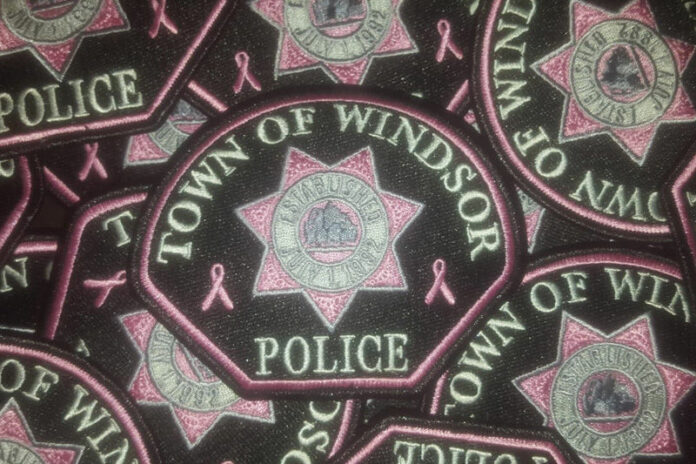At a town council meeting on Oct. 7, Windsor’s Chief of Police Ruben Martinez gave a presentation on use-of-force and related issues to the town council. The presentation was the second of its kind and was the result of a previous presentation on July 1, which triggered interest in the Brother’s Keeper Pledge and applying it going forward.
“The purpose of the first meeting on July 1 was to educate and inform the community about policies and practices in Windsor and listen to the community and receive input on experiences they’ve had with Windsor PD,” said Town Manager Ken MacNab by way of introduction. “After receiving the presentation from Chief Martinez … the council expressed interest in a number of potential reforms … For tonight’s meeting, the chief is ready to provide more information in response to council’s interest.”
The areas of potential reform the council wanted brought back included: regular reporting to the town council and the community on policing activity and use-of-force; more frequent implicit bias and cultural diversity training for Windsor Police Department officers; expanded use of the county’s Mobile Support Team (MST) in responding to calls involving emotional and/or mental distress; provision and public reporting of Windsor-specific statistics on crime and use-of-force incidents; and provision and public reporting of demographic information on crime and use-of-force incidents.
Community meetings and reporting
Martinez went through each item in turn. He proposed an annual community meeting for the month of August, or possibly early September to report statistics for Windsor relating to crimes (and comparing Windsor to other Sonoma County cities), overall incidents and contacts, arrests, use-of-force incidents and citizens’ complaints. The timing of the meeting is based on the fact that the Department of Justice releases its numbers in July each year, giving Martinez the time he needs to extract Windsor’s numbers.
In the previous meeting in July, the only statistics available were for the whole of the Sonoma County Sheriff’s Office, of which Windsor is a subsidiary. This time he was able to extract Windsor-only numbers for the previous three years.
In 2019, Windsor PD made 12,743 contacts, resulting in 789 arrests and 17 use-of-force incidents. The percentage of contacts resulting in arrests was 6.19% and the percentage of those arrests resulting in use-of-force was 2.15%. The overall percentage of contacts resulting in use-of-force is 0.13%.
These numbers are not radically different from previous years. Compared to 2018, there were fewer contacts, more arrests, one more use-of-force incident and minimal percentage changes in the other categories.
Martinez also broke out the type of use of force utilized in the various incidents over the last three years. He was quick to point out that the “carotid hold,” a restraint implicated in many deaths and now illegal in the county, had not been used by any Windsor PD officers in the previous three years.
The most frequent use of force type was the “control hold-twist lock,” which Martinez described as the arms of the subject being pulled and twisted behind their back, with 15 incidents of use in both 2019 and 2018. The next most common type is “personal body weapons — palm strikes, body strikes, etc.” which are blows to the body of the subject. This technique was utilized five times each in 2019 and 2018.
As a side note, the police K9 was “deployed” (defined as biting and restraining a subject) only once in the last two years. Windsor’s police K9 Mako passed away earlier this year, and Martinez announced the department had acquired a new K9, an 18-month-old Belgian Malinois named Duke who had just completed his training course with his new handler.
Implicit bias training
The council has expressed interest in increasing implicit bias training for their officers, and Martinez brought forward several options for that training and asked the council for direction on which one to pursue. The challenge in making a selection was a combination of cost of some programs and the fact that COVID made it unclear exactly what in-person trainings might be available.
The best training was deemed to be that provided by the Museum of Tolerance in Los Angeles, but the cost was deemed to be approximately $26,000 to provide it to the entire force. In addition, that environment (plane flight, hotels, etc.) would be challenging in a COVID environment.
Vice Mayor Esther Lemus had done that training previously, and agreed it was excellent, and stated she had heard the museum was offering programs via grants that would bring instructors from the museum into police departments for the training at significantly less cost. Martinez agreed to look further into that option, but he and the council agreed at the moment the most likely option was a webinar done by a company out of Nashville, that would cost $1,800 plus the overtime paid to attending deputies.
Finally, Martinez said he had been informed just that morning that the sheriff’s department was looking to add implicit bias and de-escalation training into its regular, quarterly firearms and takedown trainings.
“What they are going to do is integrate the training into those four hours every quarter, so by end of year you have an additional two hours at no cost to the town,” Martinez said.
Mental health calls for service
Another issue the council put on Martinez’ list was the issue of calls related to mental health issues. Martinez praised the MST program as making a significant difference in outcomes, and asked Bill Carter, director of the county’s Behavioral Health Division, and Karin Sellite, the client care manager for Behavioral Health, to discuss their program and its interaction with law enforcement.
“For a mental health call, the response is a minimum of two deputies,” Martinez said, adding the challenge of such calls is that they never know what they are walking into, whether a subject will be cooperative or combative, ill, lucid or anything else. “We don’t know … what mental health stage they’re in.”
According to Sellite, the MST started in fall 2012 in Santa Rosa and Windsor and has now expanded to other locations. The teams are currently staffed Monday through Friday from 1 to 9 p.m. They only take calls from law enforcement, not the community at large. The team does not deploy to calls that represent a safety issue, such as a subject with a weapon or a threat of harm, but they will stand by and come in when the threat has been removed.
“Aside from that, we go to anything that we’re asked to go to,” she said. “Typically, when we’re involved it’s a mental health or substance issue or someone needing resources. Twenty-five to 30% of the time we end up putting an individual on an involuntary hold.”
The rest of the time, according to Sellite, the focus is on getting the subject through the crisis and connecting them with resources useful to their particular situation. She added that the MST is not able to do transport of the subjects who do need to be placed on a hold, but that they do follow the transport to ensure continuity of care.
Carter mentioned some upcoming changes to the program, due to a recent budget decision by the county board of supervisors: a new MST team focused on the north end of the county all the way to Cloverdale will be added, staffing will be increased to have coverage seven days a week, 20 hours a day and finally they are working on models by which dispatch would call in a MST team directly rather than it going through law enforcement first.
He also stated that passage of Measure O would aid in the long-term stability of the program.
“This measure would bring resources to allow us to fill gaps and stabilize our budget, which is not stable year to year,” he said. “It would impact MST because the goal is to expand further. Maintaining requires local dollars but also need to expand the shift — we’re missing some windows we want to have so we’re covering 20 hours a day, seven days a week.”
In 2019, Windsor PD had 82 mental health calls for service, down from 97 in 2019. This far in 2020, they have fielded 32.
More concrete plans on implicit boas training and scheduling of reports and community meetings will come back at a future town council meeting.








